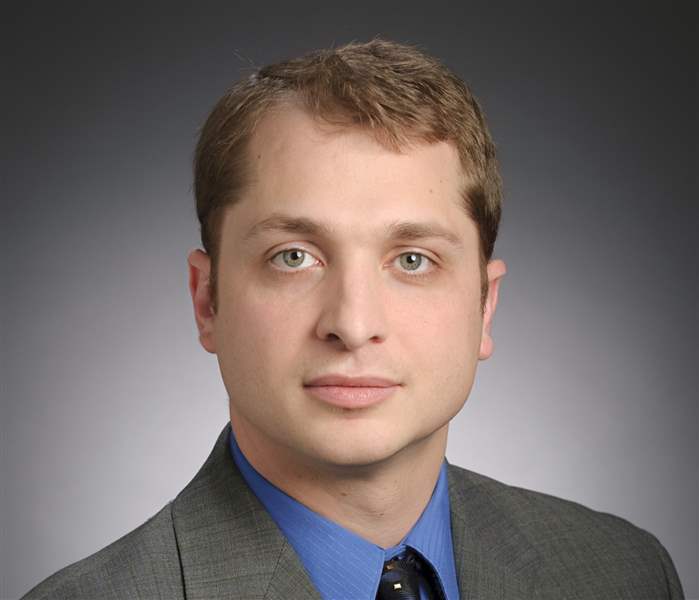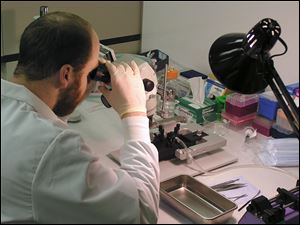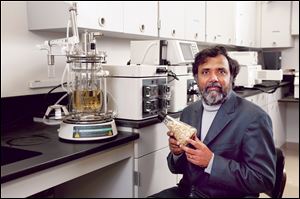
From campus to commerce
UT program helps turn technology developed in its labs into products
3/20/2011
Davies

A technician works at Mithridion, a Wisconsin company that develops treatments for Alzheimer's disease and other nervous system conditions. In 2008, it purchased a company founded by UT professors.
The Sylvania firm is developing a blood volume replacement product to treat trauma patients -- a technology that was initially developed by a trio of UT researchers.
Todd Davies, the firm's chief executive officer, said it is on track to bring the product to market in seven or eight years.
UT has aided ADS by connecting the firm with investors and other business resources. Mr. Davies hopes the company will repay the favor by becoming a success story for northwest Ohio.
"The product has such a high value on the market that, when we do hit the market, it will pay for everything," said Mr. Davies, whose company started in 2008.
ADS Biotechnology is one of 14 companies that have sprung out of UT's technology transfer program in recent years. University officials, as well as local economic development groups, say the program is playing an instrumental role in creating the next generation of high-tech start-up companies in metro Toledo and around the country.
In turn, they hope these businesses will bring jobs and revenue to the region.
"The smartest thing that we can do is to help create spin-off businesses that take the best technology at the university and convert it into products and services," said Daniel Kory, UT's associate vice president for intellectual property and technology transfer.
Transferring university technology into a marketable product can be big business nationally, bringing prestige and money to higher education institutions.
It generated $2.3 billion for universities and other research institutions nationwide in 2009, according to the most recent figures from the Association of University Technology Managers, a national consortium of academic technology transfer professionals.
The amount of activity varies widely by university. In northwest Ohio, UT had $705,800 in licensing income and Bowling Green State University $10,500 in 2009, the association figures show. In contrast, Ohio State University generated $1.7 million in licensing revenue for 2009 and University of Michigan $18.3 million.
UT faculty members who develop inventions discuss them with the university, which pays to patent the technology if it is deemed to have money-making potential. Mr. Kory said a U.S. patent can cost $7,500 to $15,000, and an international patent "hundreds of thousands of dollars."
"It's not a measure of the creativity or the innovation," Mr. Kory said of technologies that are patented by the university. "It's whether or not the subject matter is licensable. It's a financial decision."
From there, the university can license the technology for use by companies that are either "spun off" from UT to commercialize the technology or other firms that want to incorporate the invention into their existing businesses.
From there, the university receives a portion of the sales generated from each licensed technology -- an agreement that lasts for as long as the patent is active.
Corporate guidance
In addition to providing a revenue stream for the university, the technology transfer program provides corporate guidance for researchers who are technologically savvy but may not have business acumen.

Davies
So far, UT's technologies have received 125 patents, and the university has licensed 120 technologies. Mr. Kory said each of the innovations has potential to become a commercial success.
In 2010, the university said it had $1.4 million in licensing revenue, which includes reimbursements for patent fees.
The university pays 40 percent of licensing revenues to faculty researchers who invented the technologies, and 10 percent is invested in the faculty members' future research.
The remainder is split to pay for other research through the technology transfer program and to fund university departments where the research originated.
Robin Rasor, president of the technology association and licensing director at UM, said the role of technology transfer programs has changed.
Such initiatives typically focused on bringing faculty inventions to the marketplace, she said, but have taken on the added task of facilitating local job creation.
"They've really grown to try to help their local communities and states work with the businesses," she said.
University spin-offs typically create jobs that are taken by recent college graduates, which keeps young, educated talent in the area, Ms. Rasor said. They also give faculty an opportunity to profit from their inventions, she added.
Development boost
Greg Knudson, vice president of Toledo's Regional Growth Partnership, said UT and BGSU researchers are developing technologies that could boost economic development efforts in the Toledo area.
Mr. Knudson heads Rocket Ventures, the growth partnership's investment arm that has provided grants and venture capital for several UT spin-offs.
"The more of this good technology that can stay in the region, the better off it is for northwest Ohio," he said.
Mr. Kory of UT's tech transfer office said Rocket Ventures often teams up with the university's Innovation Enterprises, an early-stage investment program, to provide up to $1 million in capital for fledgling tech firms that conduct business in northwest Ohio.
That money, as well as use of university facilities, assistance from local business agencies, and other incentives can encourage companies to open and grow offices locally, Mr. Kory said.
Jobs estimate

Praveen Paripati, president of SuGanit Systems Inc., a Virginia company that has licensed a UT technology to develop an ethanol-making process, says UT has been instrumental in helping SuGanit prepare to grow.
Others hope to emulate the hiring and sales growth of Xunlight. SuGanit Systems Inc., a Virginia firm with an office in Toledo, has licensed UT technology to develop a process for making ethanol, an alternative fuel.
The company has four local employees and hopes to add five in the next several months.
The company has not generated revenue, but it has received grants from Rocket Ventures and the state department of development. SuGanit has received about $3.2 million from Ohio's Third Frontier grant program, including a $2 million grant approved last week that will allow the company to boost its production capabilities.
President Praveen Paripati said UT has been instrumental in helping SuGanit prepare to grow beyond its initial research and development phase. The company plans to create 130 jobs and generate up to $50 million in annual revenue when it reaches commercial production, according to an application the company filed with the state.
"They have been extremely cooperative, and ... I believe that distinguishes UT from a lot of other universities," Mr. Paripati said. "They seem to be going out of their way."
BGSU is working to develop a technology transfer program that could foster similar companies.
The university has generated four spin-off companies since 2007, when BGSU began to put a heavier emphasis on commercializing its faculty inventions, licensing officer John Kane said.
"It's no longer in its infant stage," he said. "It's now sort of in its toddler stage, and it's just beginning to grow."
Bowling Green's technology transfer program is smaller than UT's because the school doesn't have some programs that typically foster innovation, such as a medical school, Mr. Kane said. Still, the school has worked to capitalize on its academic strengths, such as computer science and other technology-related fields.
Blue Water Satellite Inc. of Bowling Green is the first company to be spurred from BGSU's innovation. Employing methods developed by a Bowling Green researcher, the company uses satellites to help water-quality agencies detect toxic blue-green algae in lakes.
CEO Milt Baker said the company, founded in 2008, has done work for agencies across the country, as well as in Canada, Australia, China, and Guatemala. Although he declined to discuss revenue, Mr. Baker said Blue Water's sales were seven times higher in 2010 than in the previous year.
As Blue Water continues to grow, Mr. Baker said, the firm has been able to take advantage of continued support from BGSU, such as a program that connects local companies with student employees. "We are working with BGSU on that program and will undoubtedly have students in for the summer working with us," he said.
Broad impact
Local technology transfer programs are having an impact beyond northwest Ohio. For instance, NuMe Health, a biotechnology company that spun off from UT last year, is based in New Orleans. Mithridion Inc., a pharmaceutical company that develops treatments for Alzheimer's disease and other nervous system conditions, is based in Madison, Wis.
In 2008, Mithridion purchased a Toledo company founded by UT professors Wayne Hoss and William Messer, Jr., for $2.3 million. Today, one of the company's 12 employees is in Toledo, and Mr. Hoss and Mr. Messer are part of Mithridion's corporate leadership. The company continues to pay licensing fees to UT.
CEO Trevor Twose said Mithridion hopes to perform clinical trials for its medications in Toledo, and believes the treatments may one day be developed in collaboration with a large pharmaceutical company. UT's support of the company provided an early pathway for Mithridion's projected success, he said.
"I think this connection is exactly how many young exciting new companies form," Mr. Twose said.
Contact Sheena Harrison at: sharrison@theblade.com or 419-724-6103.